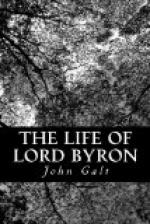On the 24th October, 1643, Sir John Byron was created Lord Byron of Rochdale, in the county of Lancaster, with remainder of the title to his brothers, and their male issue, respectively. He was also made Field-Marshal-General of all his Majesty’s forces in Worcestershire, Cheshire, Shropshire and North Wales: nor were these trusts and honours unwon, for the Byrons, during the Civil War, were eminently distinguished. At the battle of Newbury, seven of the brothers were in the field, and all actively engaged.
Sir Richard, the second brother of the first lord, was knighted by Charles I. for his conduct at the battle of Edgehill, and appointed Governor of Appleby Castle, in Westmorland, and afterwards of Newark, which he defended with great honour. Sir Richard, on the death of his brother, in 1652, succeeded to the peerage, and died in 1679.
His eldest son, William, the third lord, married Elizabeth, the daughter of Viscount Chaworth, of Ireland, by whom he had five sons, four of whom died young. William, the fourth lord, his son, was Gentleman of the Bedchamber to Prince George of Denmark, and married, for his first wife, a daughter of the Earl of Bridgewater, who died eleven weeks after their nuptials. His second wife was the daughter of the Earl of Portland, by whom he had three sons, who all died before their father. His third wife was Frances, daughter of Lord Berkley, of Stratton, from whom the poet was descended. Her eldest son, William, born in 1722, succeeded to the family honours on the death of his father in 1736. He entered the naval service, and became a lieutenant under Admiral Balchen. In the year 1763 he was made Master of the Staghounds; and in 1765, he was sent to the Tower, and tried before the House of Peers, for killing his relation and neighbour, Mr Chaworth, in a duel fought at the Star and Garter Tavern, in Pall-mall.
This Lord William was naturally boisterous and vindictive. It appeared in evidence that he insisted on fighting with Mr Chaworth in the room where the quarrel commenced. They accordingly fought without seconds by the dim light of a single candle; and, although Mr Chaworth was the more skilful swordsman of the two, he received a mortal wound; but he lived long enough to disclose some particulars of the rencounter, which induced the coroner’s jury to return a verdict of wilful murder, and Lord Byron was tried for the crime.
The trial took place in Westminster Hall, and the public curiosity was so great that the Peers’ tickets of admission were publicly sold for six guineas each. It lasted two days, and at the conclusion he was unanimously pronounced guilty of manslaughter. On being brought up for judgment he pleaded his privilege and was discharged. It was to this lord that the poet succeeded, for he died without leaving issue.




